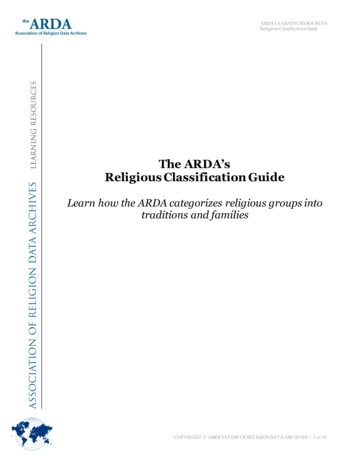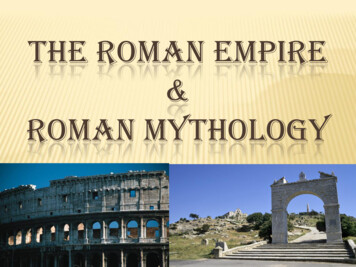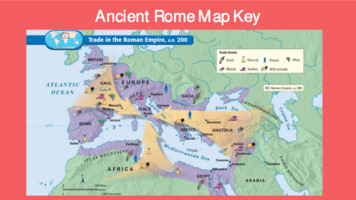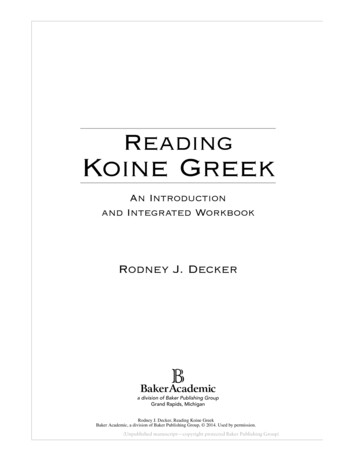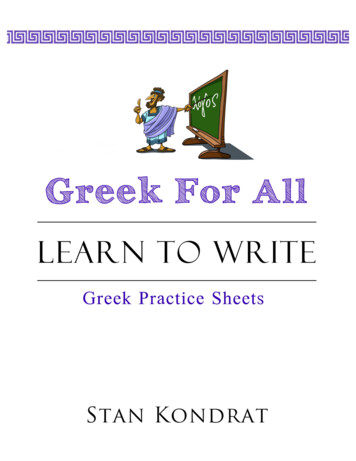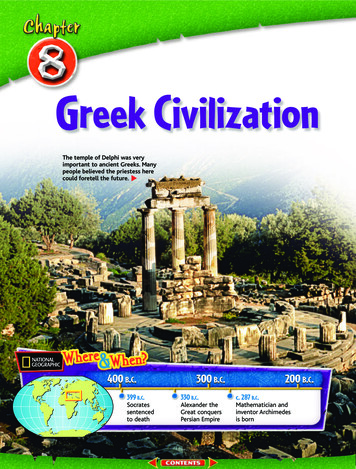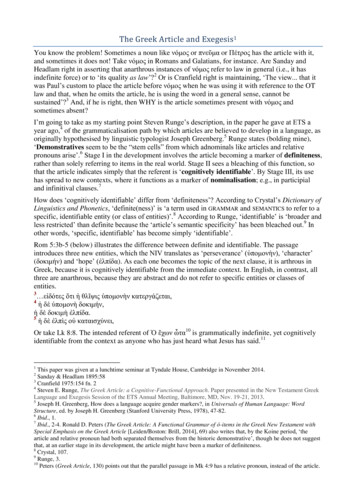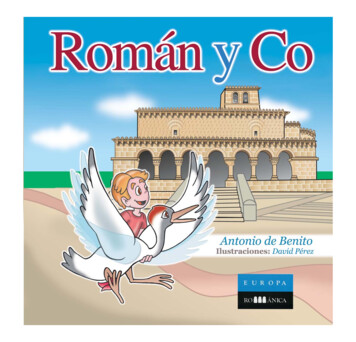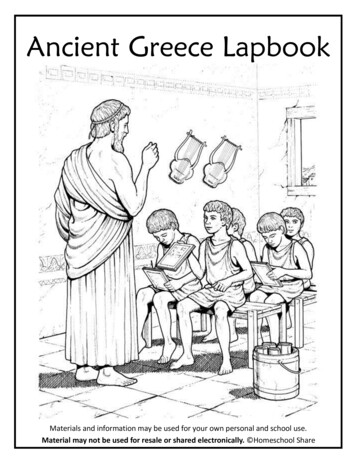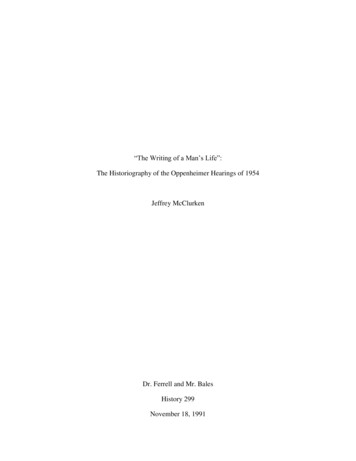
Transcription
Greek Historiography, Roman Society, Christian Empire:The Ecclesiastical History of Eusebius of CaesareaByDavid John DeVoreA dissertation submitted in partial satisfaction of therequirements for the degree ofDoctor of PhilosophyinAncient History and Mediterranean Archaeologyin theGraduate Divisionof theUniversity of California, BerkeleyCommittee in charge:Professor Susanna K. Elm, ChairProfessor A.A. LongProfessor J. Rebecca LymanProfessor Carlos F. NoreñaSpring 2013
1AbstractGreek Historiography, Roman Society, Christian Empire:the Ecclesiastical History of Eusebius of CaesareabyDavid John DeVoreDoctor of Philosophy in Ancient History and Mediterranean ArchaeologyUniversity of California, BerkeleyProfessor Susanna Elm, Chair“Greek Historiography, Roman Society, Christian Empire: the Ecclesiastical History ofEusebius of Caesarea” addresses a major shift in Roman social, political, and religious history atthe pivotal turn of the fourth century AD. When Christianity was legalized in 313, the Christianchurch of the eastern Roman Empire, where the pagan Licinius ruled as emperor until theChristian Constantine defeated him in 324, remained in an insecure position. The Greekspeaking eastern Roman elite of this period only admitted outsiders to their circles who displayeda civilized manner of life inculcated in the elite Greek educational curriculum (paideia), the kindof life embodied by Greek philosophers. It was, I argue, to depict this newly legalizedChristianity as the models of the philosophical life that Eusebius of Caesarea wrote the firsthistory of the church in the 310s AD. Whereas Eusebius’ Ecclesiastical History is usuallystudied for its intra-Christian discourse, this study considers the History as a Greek text aimed atRoman elites. I demonstrate that the History’s reconfiguration of Greek historiographical genresconstructed Christianity as a civilized and educated institution whose leaders were worthy toeducate and advise the Roman ruling classes.The first three chapters present a reading of the Ecclesiastical History within the rich varietyof Greek historiographical genres. The first chapter applies genre theory to show that Eusebius’History was a combination of the Greek genres of national history and philosophical biography.This combination of genres presented the church as a nation of philosophers ready to assume thestandard role of philosophers in the Roman Empire, of teaching Roman elites a civilized mannerof life and of advising Roman emperors. The second chapter scrutinizes the character ofEusebius’ Christianity by studying eighty mini-biographies embedded into the History that echoDiogenes Laertius’, Philostratus’, and Porphyry’s philosophical biographies. By highlightingChristians’ homogeneous and universal intellectual prowess, these profiles represent the churchas reliable educators and advisors. The third chapter argues that, in a riposte to the grand genre ofGreek war history that valorized other nations’ pasts, Eusebius transformed persecution andmartyrdom from an orderly legal procedure into a violent struggle told in the manner of the greatGreek historian Thucydides. As the church’s enemy in the struggle martyrdom was Satan and notthe Roman persecutors of Christianity, Eusebius could call martyrdoms “wars contested forpeace in the soul,” critiquing Greek war history with Greek philosophical discourse. His churchemerges victorious by remaining steadfastly loyal to God, surpasses the warriors in Greek
2literature by its virtuous conduct of the wars, and, by scapegoating the demons, absolves theRoman Empire of any systemic flaw that would discourage Christians from supporting it.The next three chapters complement my analysis of the Ecclesiastical History’s genres bylocating Eusebius’ Christianity in the social structures of the early fourth-century RomanEmpire. The fourth chapter introduces Eusebius’ experience of living under Rome through athick description of the archaeological remains of his home city, Caesarea Maritima. Caesareawas unmistakably a Roman creation, as the governor of Palestine resided there and the city’stopography featured numerous monuments to Roman power, including monuments tophilosophers who were respected in the city. The peaceful, prosperous and well-connected lifethat a wealthy man such as Eusebius could live there solidified Eusebius’ loyalty to the RomanEmpire. The fifth chapter shows how Eusebius integrated the church into the Empire: hedelineated networks of bishops and intellectuals that stretched across the Empire fromMesopotamia to Gaul and Carthage. The geographically diffused church displays a variety ofmechanisms for maintaining long-distance cohesion, and the cohesive and homogeneousphilosophical church bound together by these ties attracts favor from Roman leaders throughoutthe History. Through these encounters Eusebius patterned the church’s relationship with theEmpire after that of Greek philosophers: philosophers typically stayed in contact with emperorsand governors while maintaining a critical distance from imperial power, so as to provideimpartial advice for imperial officials. Eusebius placed Christians into the beneficial imaginedrelationship that philosophers had held with the Empire, from which they would strengthenimperial governance. The sixth chapter contextualizes the History in Eusebius’ larger literaryoeuvre. He published the History when he was writing his long magnum opus, the GospelPreparation and Gospel Demonstration, a comprehensive exposition and defense of Christiandoctrine. Eusebius’ simultaneous publication of the Preparation-Demonstration with the Historyemulated the combination of expository works with biographical narratives in Greekphilosophical curricula. Eusebius’ forging of a comprehensive program for training Christians tothink and act as philosophers positioned the church to displace Greek philosophical schools asthe premier intellectual institution of the Empire. From this position, the church could thenreinforce the Empire’s mission to civilize the inhabited world.The History articulated a central role for Eusebius’ church in Rome’s imperial regime. Wherethe most prominent role of Greek philosophers was to educate imperial elites and advise Romanemperors, Eusebius’ assertion of Christians’ intellectual prowess claimed the church’ssuperiority as a philosophical institution. Eusebius published his vision at a fortuitous moment,for when the Christian emperor Constantine conquered the eastern Roman Empire in 324, theHistory had already advertised church leaders’ competence in the philosophical profession. Bytelling the church’s history within the Greek historiographical tradition stretching back toHerodotus and Thucydides, therefore, Eusebius’ History became a catalyst for the church’sintegration into the power structures of the Roman Empire in the fourth century.
iparentibus amantibuset uxori carissimae
iiAcknowledgmentsAs this is a study of how a constellation of literary topoi reflect a social agenda, to begin withthe topos, it seems appropriate to begin with a topos common in acknowledgments butnonetheless typically accurate: This study has really been a group project. While it is tempting todismiss topoi as mere shibboleths or misdirection, my efforts in completing this dissertation haveexposed just how dependent on others my work has been. I can scarcely count the number ofpeople who deserve thanks for helping to bring this project to completion and will therefore tryto thank as many as have noticeably improved this project. To be sure, another topos also holdsfull force: none of the following is responsible for this study’s faults.Susanna Elm has been an enthusiastic Doktormutter. She has encouraged the project from thevery beginning and has provided heavy doses of tough love, particularly in always pushing me totake a break from the weeds of evidentiary minutiae and to think about the wider historicalimplications of Eusebius’ work. This dissertation would have been a far lesser work without herguidance, which has improved every page of this study.The other members of my dissertation committee have complemented Susanna’s strengthsreadily and happily. Rebecca Lyman’s combination of a listening ear and incisive, timelycommentary has never ceased both to stimulate and to reassure. Carlos Noreña has been a font ofwell-considered scholarly advice about constructing an argument and knowledge about Romangovernments and built environments. Tony Long’s knowledge of so many fields of ancientculture has kept me on my toes about points where I otherwise would have made quickjudgments (especially in my translations of Greek texts).It has been a privilege to speak so frequently with several other scholars working on the sameneglected author throughout my dissertation. I was most fortunate that James Corke-Websterwon a Fulbright fellowship to bring his groundbreaking work on the Eusebius to Berkeley in the2012-2013 academic year. James’ combination of a sharp critical eye and encouraging wordsforced me to rethink numerous assumptions and replenished my confidence at difficult points. Itis perhaps fitting that his Eusebius, more than mine, is an advocate of intellectual community, ashis presence generates lively scholarly community. I have also benefited from many aconversation with Megan Hale Williams, whose reminders to contextualize everything havegenerated a greater understanding of Eusebius’ political situation. The always careful and kindAaron Johnson has provided regular guidance and support despite his busy schedule. JesseTorgerson has been the most stalwart of scholarly companions: although (or perhaps because?)we work on different historiographical projects, we have run for years in parallel lanes, and Jessehas improved my scholarship in ways irreducible to annotations at the bottom of a page.In addition to those already named, several busy scholars have taken the time to read mywork at various stages and offer helpful suggestions that have significantly improved the project.Ari Bryen, Patrick Clark, Hal Drake, Erich Gruen, and Eli Weaverdyck will always have mygratitude for their improvement of my work.Several scholars have been kind enough to share unpublished work that has enriched myresearch. For this I thank Rajiv Bhola, Ari Bryen, James Corke-Webster, Aaron Johnson,Candida Moss, Ken Olson, Jeremy Schott, Anna Uhlig, and Arthur Urbano.In Berkeley the staff of the Graduate Group in Ancient History and MediterraneanArchaeology has been indispensable. Andrew Stewart and Ted Peña as program chairs, andMarian Feldman and Carlos Noreña as graduate advisors, have made sure that my research
iiiadvanced and that even amid difficult times, all of their students have had needed resources. Theadministrative staff of the Graduate Group—Sarah Calderon, Cassandra Dunn, CandaceGrosskreuz, Nancy Lichtenstein, Gary Spears, Jenny Smith, and Janet Yonan—has always keptme informed of important bureaucratic matters, accommodated my circumstances, and remainedcheerful at the office.In the Art History and Classics Library at Berkeley John Ceballos, Trina Lopez, and KathrynWayne have maintained a stimulating space full of scholarly resources and have gone out of theirway to provide me with books that I would not otherwise have seen. I was also fortunate to workat the Robbins Collection in Boalt Hall, where Jennifer Nelson has provided not only a helpfulcollection of early Christian and Roman legal works that would otherwise have been difficult toobtain, but also a welcoming and relaxing work environment.I have been fortunate to receive the funds needed to focus on testing my ideas—anexperience that has reinforced my assertion (chapter 4) that Eusebius could not have carried outhis scholarship under different economic conditions. For 2009-10 I received a Dean’s NormativeTime Fellowship from the Graduate Division of the University of California, Berkeley, and for2011-12 the Mabelle McLeod Lewis foundation provided a Dissertation Grant. In addition,several travel grants from Heller Fund of the Classics Department and from the Graduate Groupin Ancient History and Mediterranean Archaeology allowed me to attend conferences and meetscholars who have stimulated my work.I had the good fortune to enjoy a Forschungsaufenthalt in fall of 2010 at the Kommission fürAlte Geschichte und Epigraphik in Munich, whose marvelous ancient history librarysignificantly enriched my thinking about Eusebius’ built environment. I wrote the first drafts ofwhat became chapters 4 and 5 of the dissertation there. Rudolf Haensch was an attentive andcritical sponsor, and Christof Schuler gracious and hospitable as the institute’s director. Thegenerosity of Roland Färber, Peter Rothenhöfer, Sara Saba, Ursula Vedder, Regina Gruber,Julian Hollaender, and Sophia Bönisch made my time in Munich pleasant and productive. TheGerda Henkel und Jacobi Stiftung provided the stipend (with supplemental travel funding fromthe Sara B. Aleshire Center for the Study of Greek Epigraphy) that underwrote my stay.The opportunity to present early versions of some of my chapters abroad has also benefitedthis study. In Nijmegen in December of 2010 I presented an early version of chapter 5 at theOIKOS/Impact of Empire Research Group meeting; I thank Liesbeth Claes, Jan Drijvers, LienFoubert, Olivier Hekster, Erika Manders, and Daniëlle Slootjes for their efforts in arranging mystay. At Oxford in April 2012 I had the privilege of presenting another version of the samechapter to a sharp group of classicists, kindly arranged by Kate Cooper, James Corke-Webster,Conrad Leiser, Melissa Markausas, Dirk Rohmann, Jamie Wood, and funded in part by travelawards from the Heller Fund of the Berkeley Classics Department and the Graduate Group inAncient History and Mediterranean Archaeology. My work is far stronger for the scrutiny ofthese researchers from across the Atlantic.Thanks to travel grants from the Graduate Group in Ancient History and MediterraneanArchaeology and to Berkeley’s Graduate Division I was able to spend two weeks investigatingthe site and the objects of Caesarea in July and August of 2011. I would not have gone toCaesarea had Andrew Stewart not sat me down and suggested that I journey there; with hischaracteristic beneficence he also made numerous helpful suggestions for questions to ask inIsrael. Ken Holum was also kind enough to meet me, to answer many of my questions, and to putme in touch with the Israeli excavators of Caesarea. In Israel, Rina and Arnon Angert of the SdotYam Museum were most generous in allowing me to inspect the museum’s collection of
ivCaesarean objects. Peter Gendelmann offered me an expert tour of Caesarea, and he and RivkaGersht treated me to a delicious dinner and answered many of my questions about Caesarea’smaterial culture. Joseph Patrich also spent an afternoon clarifying many of my uncertaintiesabout the architecture of Eusebius’ home city. It was also fortuitous that Aris Grigoriadis was notonly in Israel at the same time when I was but also was very giving of his time, since many ofmy study photographs may not have survived the journey without his timely help.On particular topics, a number of scholars have offered assistance on points where I lackexpertise that has improved this dissertation at particular points: Jerome Baggett, BrunoBleckmann, Lukas de Blois, Richard Burgess, John Dillery, Volker Drecoll, Eric Driscoll,Werner Eck, Olivier Hekster, Tom Hendrickson, Tonio Hölscher, George Karras, Ylva Klaasen,Bart Koet, Lukas Lemcke, Lydia Matthews, Helmut Müller, Jennifer Nelson, Johannes Nollé,Josh O’Brien, Ted Peña, Elizabeth Penland, Hélène Roelens-Flouneau, Joel Rygorsky, SandraScheuble-Reiter, Alan Ross, Jared Secord, Devin Singh, Danielle Slootjes, and Andrew Stewart.And several additional scholars have responded thoughtfully as I tested ideas on them: for this Ithank Kate Cooper, Timothy Doran, Lisa Eberle, Simon Grote, Scott McGinness, CharlotteRouché, Alex Roberts, Michele Salzmann, and Norman Underwood.This dissertation also could not have been written without the help of dear friends who,outside of my academic circles, have shared my joys and sorrows of my life and motivated me indifficult circumstances. The congregation of Immanuel Lutheran Church in Alameda has been aconstant source of strength, cheer, and guidance. Timothy Doran, who traversed this road beforeme, is a paragon of living the academic and personal life to the fullest. Dawn Evinger has filledin on many tasks that I have not been able to perform in the sprint to finish. Dave Martin andMike Lahr, lifelong friends, have always stood by me.Finally, I must thank the three people most responsible both for my finishing this project andfor much more. I would not have reached this point were it not for my parents, Anna and John,who have always been present even at the most difficult moments. Their pursuit of knowledgeand careful methods for obtaining it have lighted the path for my own scholarly pursuits, andtheir attention to detail has become my own guiding principle. They have even lent me theirdiscerning eyes to proofread much of the dissertation; again, they bear no responsibility for thefaults that remain.My better half, Sandi Garcia, has been patient, encouraging, full of common sense, ready totalk out problems, and bursting with ebullience even at my most difficult moments throughoutthis project. Her formidable talents with travel planning and networking has allowed me to takeadvantage of many opportunities that I could not otherwise have exploited, and I would haveasked the range of questions that I did without the energetic inspiration that she exudes everysingle day.To these three wonderful and vital people I dedicate the study that follows.
vFiguresFigure 1: Roman Palestine (Ameling et al. 2011: 919); note, however, that by Eusebius’ day theprovince was called “Palestine.”
viFigure 2: A reconstructed map of Caesarea around Eusebius’ day; note that this figure calls thehippodrome-stadium an “amphitheater/hippodrome” and both governor’s palaces “praetoria”(Holum 2009: 188)
viiFigures 3 and 4: the Caesarea Carneades (Gersht 1999: 395; note the cross on his forehead) andthe Basel Carneades (Richter 1965: no. 1691)
viiiFigure 5: The Caesarea Euripides (Fischer 1998: no. 138)Figure 6: The Caesarea Philosopher Sarcophagus (Fischer 1998: no. 210)
ixFigure 7: a column found in the Promontory Palace at Caesarea, with squeezes of the inscriptionsdedicating the statue to Titus Flavius Maximus the philosopher and for Galerius; note that thecolumn was turned upside-down to inscribe Galerius’ name onto it (Eck 2010: 177)
xFigure 8: A plan of Caesarea’s Promontory Palace (Patrich 2010: 176)Figure 9: A reconstruction of Caesarea’s Promontory Palace (Patrich 2010: 176)
xiFigure 10: An aerial photograph of Caesarea’s three-building governor’s complex. Herod’stheater is in the foreground; behind it, protruding into the sea, is the site of the Romangovernor’s (until Diocletian) Promontory Palace; in front and to the right of the PromontoryPalace is the city’s Hippodrome-Stadium. Compare with Figure 2 (Patrich 2011b: figure 37)
xiiFigure 11: A plan of the procurator’s, and then after Diocletian the governor’s, palace atCaesarea, top story (Patrich 2010: 180)Figure 12: The bottom story of the procurator’s palace (Patrich 2011b: figure 111)
xiiiFigures 13 and 14: The base of a statue that honored Marcus Flavius Agrippa from Shuni and asqueeze of the inscription from the statue (Holum et al. 1988: 114f.)
xivFigure 15: A top plan of the Temple of Roma and Augustus at Caesarea. The plan does notinclude the colonnades surrounding the temple (see figure 17; image from Stabler et al. 2008:18).
xvFigure 16: A reconstruction of Caesarea’s Temple of Roma and Augustus as viewed bypassengers entering Herod’s harbor of Caesarea (Holum 2004: 187)Figure 17: a panel from the Caesarea cup, showing Strato coming before the Tyche of Caesarea,who holds a standard in her left hand and a head in her right. Augustus’ head overlooks the sceneon the top register (Gersht 1999: 394)
xviFigure 18: A reconstruction of a column and the entablature from Caesarea’s Temple of Romaand Augustus. The surviving fragments of a column are shaded (Holum 2004: 188)
xviiFigure 19: The great Tyche of Caesarea, possibly the cult statue of Tyche; compare to the Tycheon the Caesarea cup (figure 19; Holum et al. 1988: 12)
xviiiFigure 20: Caesarea’s colossal togate statue made from porphyry marble, probably of Hadrian(Holum et al. 1988: 125)
xixFigure 21: the northwest flank of the temple platform of Roma and Augustus. Note the niches onthe platform where statues of divinities stood (Porath 1998: 47)Figure 22: a statue of Hygeia originally located in one of the niches of figure 21 (Fischer 1998:no. 136)
xxFigure 23: Caesarea’s shrine along the edge of the hippodrome-stadium. The three niches heldstatues of Isis, Serapis, and Tyche. The shrine may have been converted into a martyr shrine inthe fourth century (Patrich 2011b: figure 34)Figure 24: The Promontory Palace and hippodrome-stadium of Caesarea. The stadium had beentruncated to its shortest length by Eusebius’ day. The chapel of figure 23 is the “sacellum” at theeast wall of the stadium. Compare with figures 2 and 10 (Patrich 2011a: figure 13)
xxiFigure 25: The site of Caesarea’s southeast hippodrome. A reconstruction of the obelisk stands inthe center of the hippodrome. Compare with figure 2 (Patrich 2011b: figure 41)Figure 26: The site of Caesarea’s amphitheater by aerial photograph; compare with figure 2(Holum et al. 1988: 85)
xxiiFigure 27: A map of Caesarea’s two northern aqueducts. The high-level aqueduct was built at thecity’s founding and renovated in the early second century; the low-level aqueduct was built inthe third century (Porath 2002: 104)
xxiiiFigure 28: Caesarea’s high-level aqueduct as seen from the shore (at point 11 on figure 28);inscriptions show that it was renovated by Roman soldiers under Hadrian (Holum et al. 1988: 78)Figure 29: The Harbor of Caesarea in the late second century AD, as its extended quays weredecaying. The local harbor of Caesarea lies to the right (Raban 1992: 123)
xxivFigure 30: The Roman road network of northern Palestine (Roll 1996: 551)
xxvFigure 31: A tentative plan of Aelia Capitolina (formerly Jerusalem; Eliav 2003: 277)
xxviFigure 32: A plan of Paneas. The moat, gate, and walls are medieval, but the aqueduct,bathhouse, sacred pool, cardo maximus, and sanctuaries are Roman, and some of the Byzantinefeatures may already have stood in Eusebius’ day (Wilson 2004: illustration 1)
xxviiContentsAbstract . .1Dedication . iAcknowledgments . . . .iiFigures .vContents .xxviiIntroduction: Greek Narrative and Roman Social History . .1Greek Narratives and Roman Rulers in Abgar’s Exchange with Jesus .1Contextualizing the Ecclesiastical History 5The Purpose of the Ecclesiastical History: Scholars’ Views . . 13Theoretical Frameworks . .20An Outline of the Argument .22Chapter 1: Genre, Imagined Worlds, and a Role for the Church .26Eusebius’ Readers and their Expectations . .29Genre and its Implications 32Ecclesiastical History within Greek Historiography: National History .41Jewish or Christian Models for Eusebian Historiography?.44Philosophical Biography as a Model for Ecclesiastical History .49To What Does the Church Compare? Philosophers in the Roman World .57Summary and Conclusions 70Chapter 2: How Eusebius Used Philosophical Biography .72Biographies Embedded into Eusebius’ History .76Information that Eusebius Downplays .79Information that Eusebius Emphasizes .84Information that Eusebius Restructures .94Conclusions 102Chapter 3: Philosophical Martyrdom as Eusebian War History .105Pre-Eusebian Martyr Narratives .107Demonic Antagonists and the Exculpation of the Empire .112Christian Armaments: Philosophical Asceticism in Eusebius’ War Narratives .118Eusebian Combat: Enemy Violence and Christian Virtue . 128Christian Victory in the Empire and in the Soul 133Conclusions: Philosophical War Historiography and the Roman Empire .138
xxviiiChapter 4: How Caesarea Maritima Shaped the Church’s History . .141Caesarean Monuments and the Honor of the Philosopher .144Eusebius’ Experience of Roman Governance .149Caesarean Civic Religion and a Place for Eusebius’ Church .159Enjoyment and Recreation in Caesarea .165Caesarea Connected: the Infrastructure of Mobility . .170Caesarea’s Normality: Eusebius’ Wider Roman World .172Conclusions .173Chapter 5: Eusebius’ Christian Network and its Role in the Roman Empire 175Interactive Habits and Social Status: A Semiotics of Connectivity 178Harmony, Self-Policing, and Replication: Strong Ecclesiastical Ties 185Weaker Ties with Non-Christians: Intellectuals and Statesmen 195Conclusion: the Potential Strength of Weak Ties 206Chapter 6: A Christian Curriculum, a Nation-School, and Roman Imperialism .209The Audience of the Ecclesiastical History and Eusebius’ Contemporary Works . .210Christian Elites in the Greek-Speaking Roman Empire under Licinius .213The Purpose and Precedent of the Preparation-Demonstration and History .217The Christian Nation-School 223Christian Civilization within Roman Imperialism .230Epilogue .235Appendix 1: Dating the Ecclesiastical History 236Appendix 2: Verbatim Quotation in Greek Histories and the Ecclesiastical History .242Appendix 3: A Database of Biographies in the Ecclesiastical History 253Works Cited .259Abbreviations: Primary Sources .259Abbreviations: Journals and Publishers .260Ancient Texts .261Epigraphical Corpora . .265Modern Works 265
1IntroductionGreek Narrative and Roman Social History in Eusebius’ Ecclesiastical HistoryCar pour matière, [l’histoire] a précisément, en dernier ressort, des consciences humaines.Les rapports qui se nouent à travers celles-ci, les contaminations, voire les confusionsdont elles sont le terrain constituent, à ses yeux, la réalité même.1This study addresses a successful attempt to increase the social influence of a marginalinstitution. Eusebius’ Ecclesiastical History was the first history of the Christian church. It waswritten in the early fourth century AD, as Christian elites were joining the Roman ruling classesin large numbers. For most of the Roman Empire’s existence the church had been perceived aslower-class and marginal, and therefore disreputable. The History countered this perception byusing Greek literary techniques to cast Christians as strong candidates for an elite Roman role,that of the philosopher. Eusebius must therefore be read as a Roman imperial author writing inthe Greek historiographical tradition, and not merely a Christian author.1. Greek Narratives and Roman Rulers in Abgar’s Exchange with JesusOne episode offers an excellent pars pro toto for Eusebius’ presentation of the Christian past.While the Ecclesiastical History informs readers about Jesus in its first book, it narrates only oneepisode about Jesus not found in the canonical gospels.2 This is an encounter between Jesus andKing Abgar of Edessa (HE 1.13).3 Eusebius first summarizes the encounter in his own words(1.13.1-5), and then inserts a translation of a Syriac version of the story (1.13.6-21), includingtexts of the letters purportedly exchanged between Abgar and Jesus (1.13.5-10).4In Eusebius’ narrative, Jesus’ power becomes so renowned that he draws the attention of adistant king, Abgar, the distinguished monarch of the Mesopotamian kingdom of Osrhoene, whoruled his kingdom in the city of Edessa (1.13.2).5 After contracting an unspecified incurabledisease, Abgar sends a letter to Jesus asking the savior to travel to Edessa and heal him (1.13.2,6-9). In a letter responding to Abgar,6 Jesus declines Abgar’s request, but promises to send adisciple to heal his sickness and save him and all his subjects from damnation (1.13.3, 10). Jesus’promise finds fulfillment through the apostle Thomas, who in obedience to a vision sends1Bloch 1949: 87.Book 1’s “narrative chapters seem almost more concerned to argue than to narrate,” notes Barnes (1981: 129).On book 1 of the History as commentary, see Morlet 2008, Muckensturm-Poulle 2010; cf. Armstrong 2006.3The story survives independently in a Syriac narrative called the Teaching of Addai, usually dated to the laterfourth century (see e.g. Griffith 2003, Mirkovic 2004: 57f.). Most previous scholarship on Eusebius’ version ofAbgar’s conversion has focused on the origins of the Abgar correspondence and not on Eusebius’ use of it: see e.g.Bauer 1934: 13-15, Ortiz de Urbina 1934: 90f., Barnard 1968: 162f., Segal 1970: 64f., Drijvers 1982: 157-166,Brock 1992: 221-227, Ramelli 1999: 121-127; Ross 2001: 132f.; cf. n. 9 below.4
History was a combination of the Greek genres of national history and philosophical biography. This combination of genres presented the church as a nation of philosophers ready to assume the standard role of philosophers in the Roman Empire, of teaching Roman elites a civilized manner of life and of advising Roman emperors.
